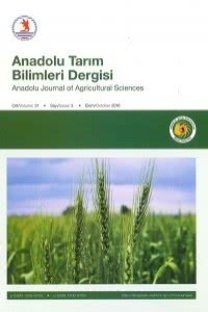The effect of an audible bird scarer on the presence of reed cocks (Parphyro Porphyro) in rice fields
Sesli bir kovucunun çeltik tarlalarında bulunan saz horozları (Parphyro Porphyro) üzerine etkileri
___
- Avery, M. L., Werner, S. J., Cummings, J. L., Humphrey, J. S., Milleson, M. P., Carlson, C. J., Primus, T.
- Bruggers, R. L., Ruelle, P., 1982. Efficiacy of nets and fibers for protecting crops from grain-eating birds in Africa. Crop Prot. 1 (1), 55-65.
- Mason, J. Russell., Linz, G., 1997. Repellency of garlic extract to European starlings. Crop Prot. 16 ( 2), 107-108.
- M., Goodall, M. J., 2005. Caffeine for reducing bird damage to newly seeded rice. Crop Prot. 24, 651-657.
- Saglam, A. C., Onemli, F., 2005. The effects of sowing date and sowing density on birds damage in the cultivators of sunflower (Helianthus annuus L.) (in Turkish, with English abstract). J. of Tekirdag Agric. Fac. 2 (1), 50-57.
- Summers, R. W., 1985. The effect of scarers on the presence of starlings (Sturnus vulgaris) in cherry orchards. Crop Prot. 4 (4), 520-528.
- Tobin, M. E., Dolbeer, R. A., Webster, C. M., 1989. Alternate-row treatment with the repellent methiocarb to protect cherry orchards from birds. Crop Prot. 8 (6),461-465.
- Vickery, J. A., Summers, R. W., 1992. Cost-effectiveness of scaring brent geese Branta b. bernicla from fields of arable crops by a human bird scarer. Crop Prot. 11 (5),480-484.
- York, D. L., Cummings, J. L., Engeman, R. M., Davis Jr. J. E., 2000. Evaluation of Flight Control and Mesurol as repellents to reduce horned lark (Eremophila alpestris) damage to lettuce seedlings. Crop Prot. 19, 201-203
- ISSN: 1300-2988
- Yayın Aralığı: Yılda 3 Sayı
- Başlangıç: 2018
Methods for improving rangelands in the blacksea region of Turkey
Sistemli yaklaşımla ekosistemin analizinde matematiksel modelleme yöntemi
Oblong delikli eleklerin çekiçli değirmenlerin performans karakteristikleri üzerine etkisi
Mehmet Arif BEYHAN, Murat DEMİRSOY, Dilek KANDEMİR, Sezgin UZUN, Harun ÖZER
Sürdürülebilir kalkınmada fiziksel kırsal alan planlaması
Turgut ÖZTÜRK, Murat MENGÜLOĞLU
Bitkisel ürünlere karşı tarımsal biyoterörizm (Agroterörizm)
Sinop ili Türkeli yöresi balarıları (Apis mellifera L.)’ nın morfolojik özellikleri
